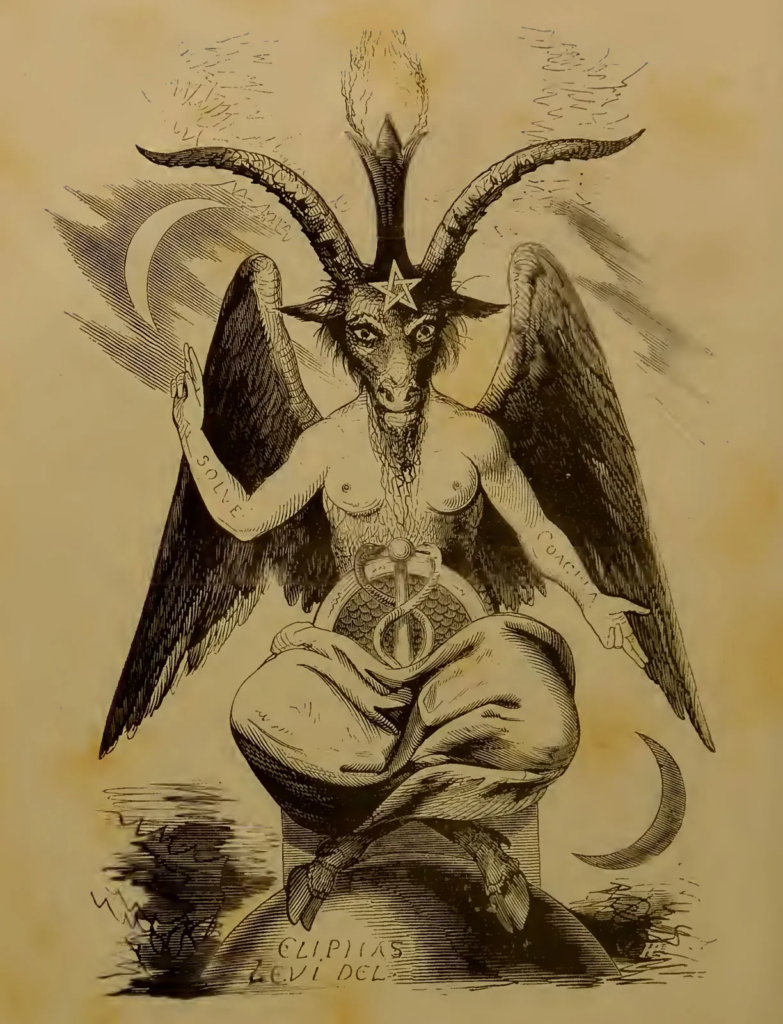Nope this is not smoking pot while summoning demons… but then again it is a difficult to define the term because many people hold misconceptions and they are often more common than the correct opinion.
Some people like to imagine that High Magic is good magic that leads to mystic pursuits and Low Magic is evil magic that panders to base needs, but that does not seem to be the context with which the term was originally used.
In his phenomenal work 3 Books of Occult Philosophy, Heinrich Cornelius Agrippa suggests that Ceremonial Magic is the highest of all philosophies. His first two books are Natural Magic and Celestial Magic through which the initiate draws their virtues (or power) from nature, plants, the elements, numbers and the planets / astrology. It is his third book where the initiate uses Qabalistical god names that he deems the “highest” of all philosophy and calls Ceremonial Magic. For Agrippa, there is definitely more of a leaning toward Pythagorean and Neoplatonic mysticism (Theurgy) than toward Qabalah. For him, some of the unmanifest concepts such as numbers and archtypes have a higher existences as perfect divine forms and connecting to these would probably be High Magic. Comparatively, lower magic would use elemental and celestial virtues. It seems the more manifest it is for him, the lower it is.
Heinrich Cornelius Agrippa’s work had such an influence over Francis Barrett that his influential work The Magus almost reads as a facsimile of Three Books of Occult Philosophy by Agrippa. In contemporary English, we prefer to call this form of flattery by another word… what was it? Oh yeah! Plagiarism. Sadly the Magus was almost entirely ignored until it influenced Eliphas Levi and then it had a massive influence over the Hermetic Order of the Golden Dawn which helped form the basis of most Neopagan ritual practice.
In the 1800s Eliphas Levi wrote his opus magnus “The Doctrine and the Ritual of High Magic” (Most frequently translated as Transcendental Magic). This furthered the idea that High Magic was Qabalistical Magic and used divine god names from Judeo-Christian religions. He compared magicians who drew their power from God to sorcerers who drew their power from the devil. So it was once again established that a connection must exist between High Magic and divine Qabalistical names.
Aleister Crowley sought to make similar contributions, but his idea of the divine did not entirely match what he termed the Old Aeon divine. So holy names such as Therion (the beast), Babalon, Nuit, Hadit, Ra-Hoor-Khuit and IAO replaced most Qabalistical names. While Thelemic morals went entirely against the morals of the old Aeon, he still respected the power of old Aeon names.
Some grimoires are divided into greater and lesser such as the Greater and Lesser Keys of Solomon. The Greater Key focuses entirely on Angel invocation and opening magical gates to the aethyrs whereas the Lesser Key is entirely focused on the summoning of demons. Both use Qabalistical names.
Modern views shared among the Neopagan community tend to suggest that High Magic today is considered Theurgy and Mysticism which draw the magician closer to deity, whereas Low Magic is Thaumaturgy or doing spells to achieve change in gross reality.
LaVeyan Satanism defined “greater” magic as the concentration of the Will to allow for a more powerful magician and “lesser” magic as causing a change in accordance with the will.
Well-Known Names
A few well-known names for their contribution to the history of High Magic or Ceremonial Magic.
Heinrich Cornelias Agrippa
What a lot of people don’t realise about Agrippa was that he was a profound feminist and actually wrote a full treatise about how women were theologically and morally superior to men in many aspects trying to undo the centuries of Greek, Roman and Christian oppression of women. He wrote through the rhetoric that they were better to find a way to firmly plant the idea that they were entirely equal to men in all things that mattered and were perfectly suited to the political and educational areas from which they had been included.
In 1533 about two years before his death he is known for writing the aptly named “Three Books of Occult Philosophy”, a three-volume text that is generally considered the main source work for most High Magic. He brought together ideas of Neoplantonism, Kabbalah, Spirit summoning and the use of hidden virtues in natural substances.
Francis Barrett’s The Magus (1800s) is almost entirely plagiarised, word-for-word from Agrippa’s work.
Dr John Dee and Edward Kelly
A member of Queen Elizabeth I’s court in the 1500s, Dee was preoccupied with the ability to use angels to spy for the Queen and achieve power for Britain. He is well-known for writing an entire system of magic, one of the only to be entirely born in England, as the result of hiring Edward Kelly as a seer and praying for Angels to appear to Edward Kelly. The result was a series of prayers or spells in an obscure language that they called Angelic and some huge tables with hidden names of angels that have remained in popular use until the modern day. These days the system of magic is known as Enochian, but to Dee and Kelly, it was simply “Angelic”.
Dee was often visited by a “Frances Garland”, a character missing from all other historical records. Kelly has a vision that this man was a spy from the treasury. They continue to speak during the very same years missing from the history of Shakespeare’s life. Years later Shakespeare wrote the Tempest with a character called Prospero who had a similar position to Dee, a similar love of books, a similar tragic loss of a library and finally worked with the same spirit that appears in Dr Dee’s notes, Ariel. Is it possible that Shakespeare had met Dr Dee under a pseudonym during his youth and based Prospero on his meetings with Dee?
Dr Dee obsessively sought after the alchemist stone while Kelly occasionally demonstrated its power, but Kelly’s actions may have been a trick.
Eliphas Levi
A catholic priest called Alphonse Louis Constant under a pseudonym, this author wrote in the mid-1800s about the use and symbols of High Magic likely coining the term. He appeared to build on the works of Agrippa, but was more focused on practical matters including ritual texts that would be read aloud.
He is well known for his drawing which combined the name Baphomet, the Goat of Mendes and some alchemical symbolism. This resulted in the famous drawing of Baphomet that inspired most Satanic groups’ statues of Satan / Lucifer.

Eliphas Levi’s descriptions of the Trumps of the tarot were used in the making of the Smith-Rider-Waite deck.
William Wynn Westcott and Samuel Mathers
The creators of the Hermetic Order of the Golden Dawn. These two gentlemen were very interested in exploring the mysteries of SRIA (the Rosicrucian Society, a man-only masonic order dedicated to the pursuit of spiritual science through Alchemy, Christian Cabala and High Magic). However, they wanted to pursue these matters in a way that wasn’t limited exclusively to men or exclusively to Christians.
They formed the order which allowed women to join and brought together characters like Bram Stoker, Sir Arthur Conan-Doyle, George Bernard Shaw, A. E. Waite (the commissioner of the most prolific tarot deck in the world), Y. B Yeats.
This group not only went on to shape the minds of the public through novels, poetry and the most well attended plays of the time, but it was crucial in giving birth to the modern Neopagan movement and lent it many of its ritual structures and symbolism. For example the pentagram was a commonly used symbol in this order.
The Hermetic Order of the Golden Dawn was one of the first Ceremonial Magic orders to focus more on pagan themes through its Egyptian connection.
Florence Farr
Albeit somewhat forgotten in the modern day, Florence Farr was one of the most well-known actresses of her day. Not only did her plays break gender roles and feature feminist and suffragette themes. They also re-awakened a love for pagan and Egyptian mystery. Her acting skills made her dramatic Occult rituals very powerful, even more so than her plays.
She was one of the most competent seers in the Hermetic Order of the Golden Dawn and wrote details about projecting through tarot cards and symbols. She contributed substantially to the Hermetic Order of the Golden Dawn’s Flying Rolls.
She went on run the London temple of the Hermetic Order of the Golden Dawn conducting regular rituals which combined themes of High Magic with Egyptian Paganism. I believe she was one of the first in a heavy push to take magic in the pagan direction.
Aleister Crowley
An infamous magician who often combined Egyptian symbolism with High Magic and some personal revelations he had in 1908 to make a new religion called Thelema.
He sought to entirely replace the Hermetic Order of the Golden Dawn with the A.’. A.’. in order to create an order which combined yoga techniques and Buddhist meditation with the Golden Dawn’s symbolism. While a very competent magician, I, personally, think he had only a passing familiarity with the history of the symbolism he used.
He is often maligned. He was kicked out of the Hermetic Order of the Golden Dawn early because of his homosexuality and promiscuous behaviour. He was called the Beast 666 by his own family, but it became a title he sought to live up to. The masonic Order known as the Ordo Templi Orientis asked him to initiate in the UK and re-wrote most of their initiation rituals eventually initiating Gerald Gardner who used his rituals and knowledge to create Wicca which led to the modern Neopagan movement.
Dion Fortune
More commonly known by her pseudonym Dion Fortune, Violet Firth was a member of the later Hermetic Order of the Golden Dawn order known as the Stella Matutina. She is well known for the prolific writing on subjects of Hermetics and Qabalah.
Firth was adamant that magic was too Christian and too male and in fact, the entire of the UK was culturally deficient. She described it as needing a supplement called Vitamin P, Paganism. Her novels sought to re-ignite a love for Paganism in a more durable way than Farr’s plays which now only existed in the memory.
For Wiccans, there are three main sources I recommend they read to better understand their own tradition and despite being a Ceremonial Magician rather than a pagan Witch, Dion Fortune is one of them.

Comments
One response to “High Magic”
[…] think of Lucifer more as a spirit guidance than the recipient of devotion. Most practice a form of ceremonial magic, but obviously the Qabalistical names are often dropped for more relevant […]